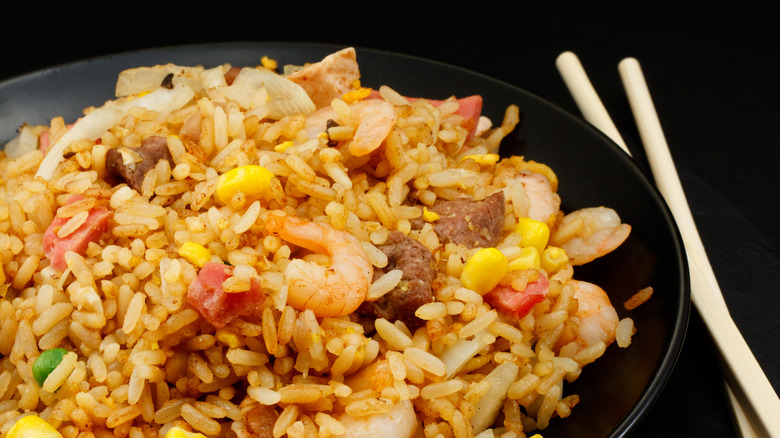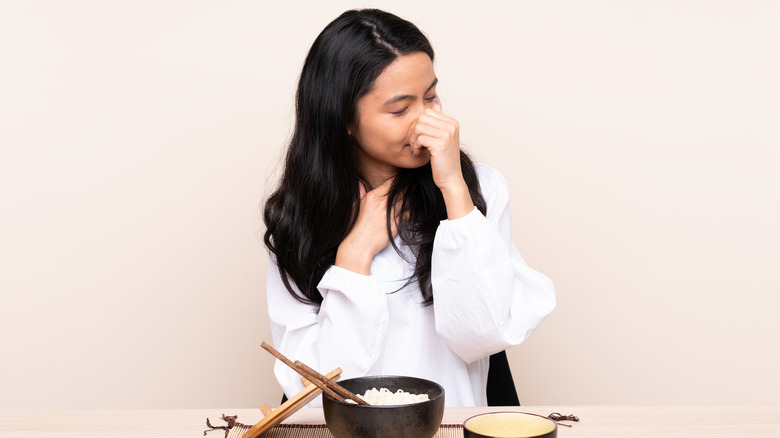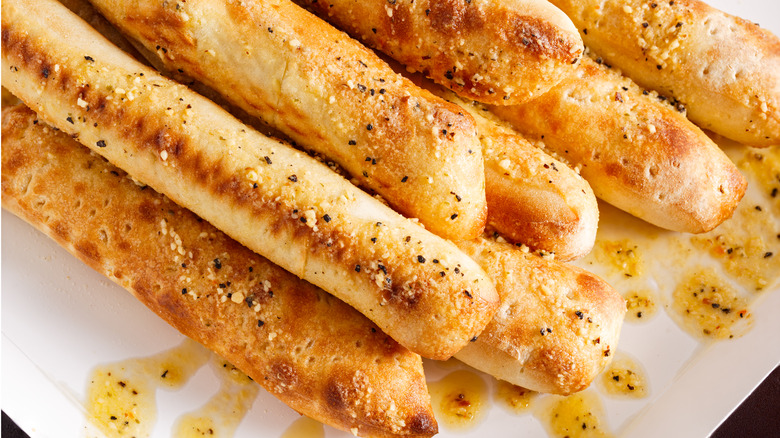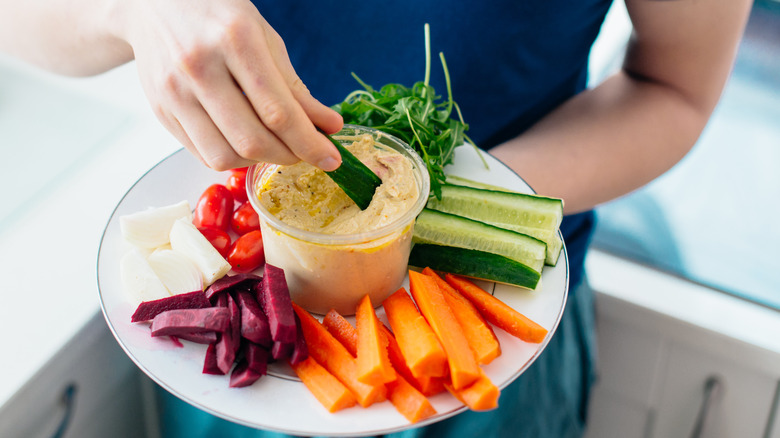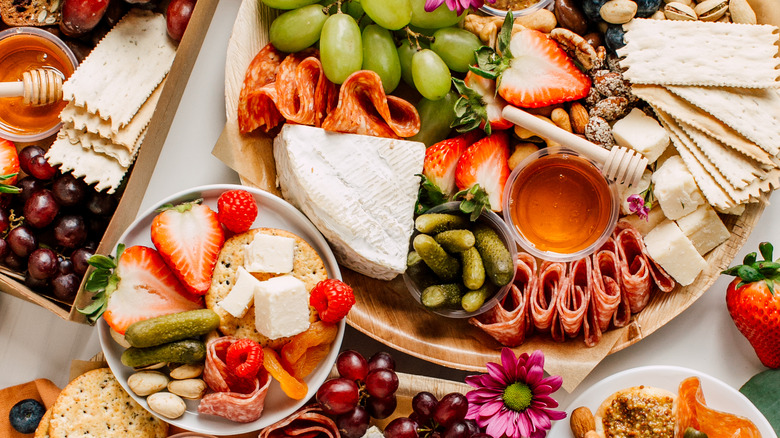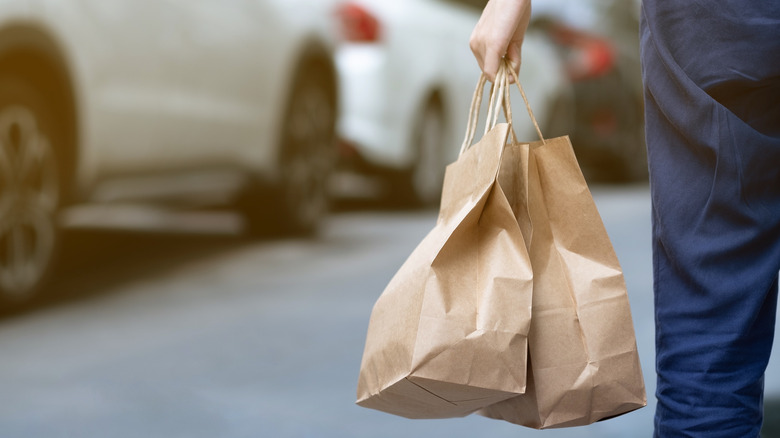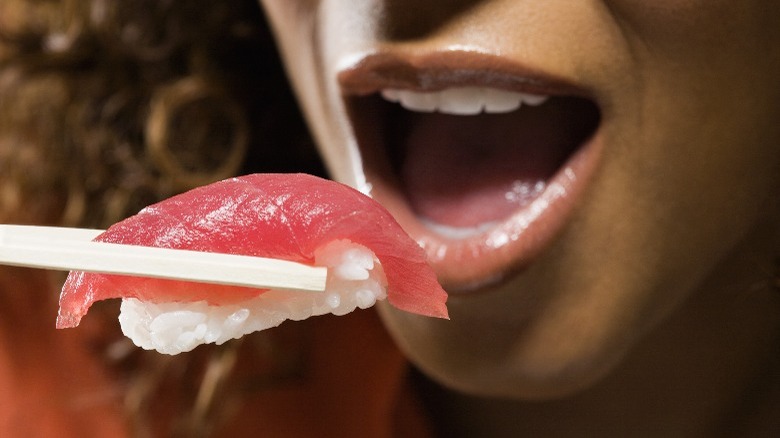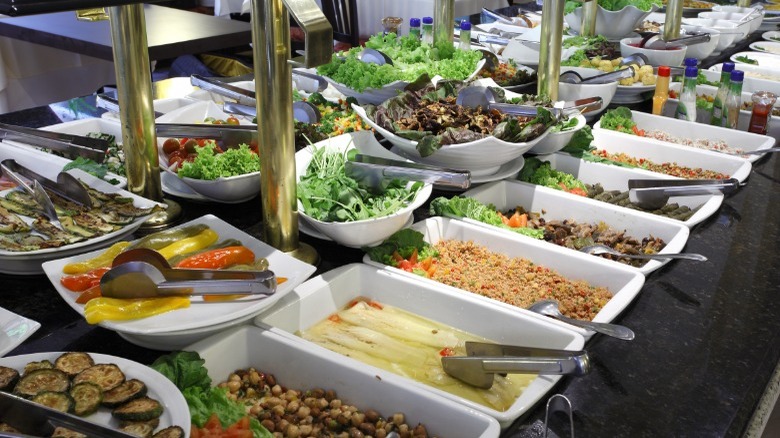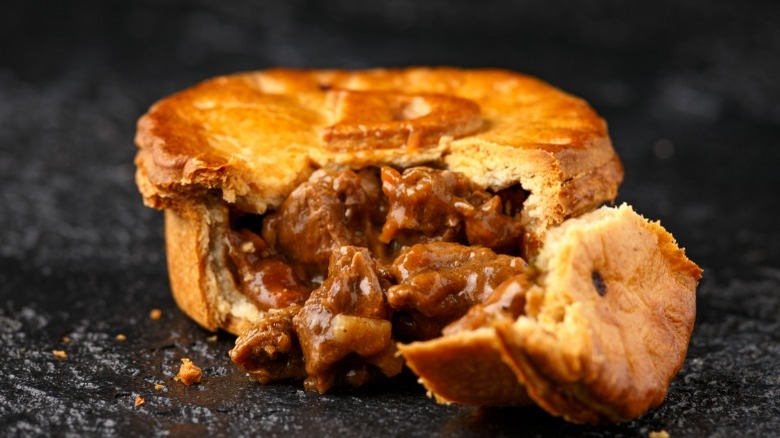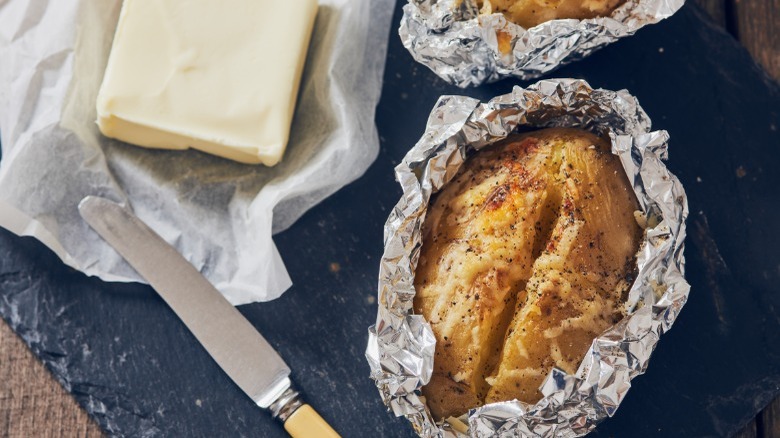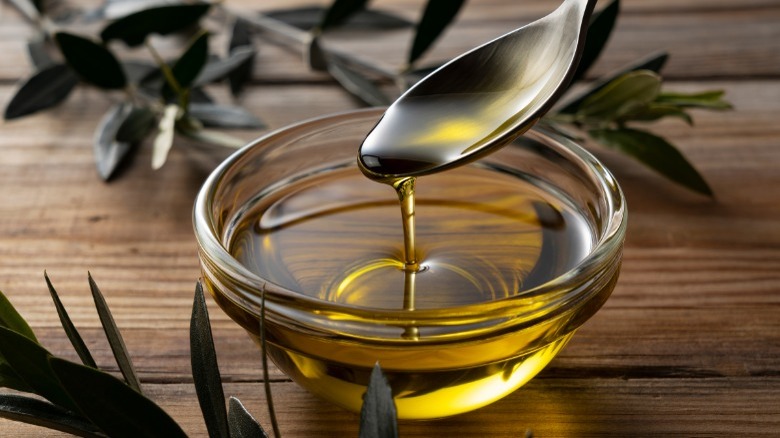Rice And Other Red Flag Foods You Should Probably Avoid On Leftovers Night
Few things make you step on the gas during 5:00 o'clock traffic like a rumbling tummy and a case of the hangries. On really good days, your speed demon ways are rewarded with a quick fix like leftover shrimp fried rice from your favorite Asian eatery. But depending on a number of factors, that leftover rice can go from treat to potential tragedy pretty quickly. Although it enjoys popularity among large swaths of the population, including hurricane preppers, cash-strapped community college students, and much of Asia, in certain instances rice and the other red-flag foods on this list aren't the gifts that you think they are.
When it comes to food poisoning, most people have heard of the usual suspects, with botulism from badly canned goods to E. coli from compromised veggies landing at the top of the list of stuff to stay away from. However, just because a food is considered shelf stable doesn't mean it gets off scot-free when it comes to introducing bad tummy bugs to your system.
Under the right conditions, these foods, at minimum, go from great to gross in the time it takes you to drive from Reno to Tahoe, and at their worst, they'll have you bowing before the altar of the porcelain goddess all night.
Rice
Certain staple foods, like pasta, potatoes, and the biggest culprit, rice, contain spores of a bacteria called Bacillus cereus. There's a reason why this vomit-inducing sickness is called "fried rice syndrome."
Unfortunately, Bacillus cereus spores don't die off in your rice cooker, either, unless you cook it at 120 Celsius (248 Fahrenheit) for an age or so, according to McGill University. While not all rice contains these spores, it's impossible to know which rice does or doesn't, so make discretion your own personal FDA when it comes to eating leftover rice.
Heat activates the spores. Once cooked, you've potentially created your own little Bacillus cereus farm if the rice stays between 10 Celsius (50 Fahrenheit) and 50 Celsius (122 Fahrenheit) as it might if you leave it warming in your rice cooker.
There are some recommendations if you feel you simply must eat your leftover rice. First, make sure it cools quickly, like within an hour of cooking, and second, don't reheat the rice more than once. However, it's really best just to toss it and start anew.
Pasta
While the so-called "fried rice syndrome" sickens around 63,000 people per year, the Bacillus cereus spore isn't content to just hang out in your rice bowl. The same bacteria that cause you to spit up your rice leftovers can infect pasta, too. One extreme example involved a young man who got so sick after eating the wrong pasta and rice dishes that he ended up in the hospital, fighting off organ failure. By the time his food poisoning ordeal was completely over, he had to have his legs and the digits on his hands amputated.
Of course, not everyone who consumes leftover pasta or rice ends up in a wheelchair. With the necessary precautions, you can eat leftover pasta, though the recommended requirements are kind of strict. As per the University of Florida Extension, aside from keeping hot foods very hot, when it comes to this bacteria, your cool-down methods should just come shy of you putting them in the blast chiller. If you can lower the temps of your leftover pasta to 41 Fahrenheit (5 Celsius) within an hour or so after cooking, you'll bypass some of the dangers of developing foodborne illnesses. The reheat-once rule still applies, though.
However, the time this food spends in your fridge should be short. You should plan on setting the mental timer on your leftover pasta to two days or less, and then toss it once the two-day mark passes.
Breadsticks
Speaking of Italian food, if you're like most people, you love those leftover breadsticks that you get from your favorite Italian eatery. But don't be fooled into thinking that the foil-lined bag they come in will keep them fresh for very long. (Here's a hint. It won't.)
While you're basically free of the threat of Bacillus cereus poisoning from bread, other factors put your leftover breadsticks in the less-than-appetizing-a-day-later category. In some cases, you don't even have to wait until your 'sticks have chilled in the icebox for 24 hours. The constitution of some breadsticks begins to "deteriorate" on the table by the seven-minute mark at some chain restaurants, like the Olive Garden.
The breadsticks that do make it past the restaurant table and into your refrigerator face their own challenges. The 300-pound electric ice chest in your kitchen has a tendency to suck the moisture out of bread. This means that your once-tasty treat morphs into a near tooth-breaker in 24 hours or less.
By the way, the no-refrigerate suggestion doesn't just apply to leftover Italian restaurant breadsticks. Generally speaking, any kind of bread left in the fridge for very long becomes crispy and not in a delicious, seasoned crouton kind of way.
Hummus
When it comes to healthy and quick food options, you can't beat hummus. This easy-to-make blend of chickpea and garlic deliciousness counts as a favorite at picnics in the park. Just break out the crackers, carrot sticks, and some kalamata olives for good measure.
However, for a recipe that is purported to go back at least 3,500 years, your picnic hummus has a very short shelf life. The Mayo Clinic warns that food hanging out at room temperature teeters close to the food poisoning danger zone of 40 degrees Fahrenheit (4 Celsius) and 140 degrees Fahrenheit (60 Celsius) within two hours. If the temp spikes higher during your average summer picnic, like up into the 90s, that time frame drops down to just an hour before possible food poisoning starts to set in.
If you know that your hummus needs to go the distance for a get-together, you have a couple of options. You can wait to serve it until closer to dinnertime, or you can put the hummus bowl on a bed of ice for the duration of your meal.
As for saving that spendy kalamata-garnished bean dip that you got from the gourmet food store on your way to the party, it'll go bad as quickly as the cheaper versions of this ancient recipe. Do yourself a favor and leave it in the trash on your way out of the park.
Charcuterie
With the average charcuterie board going for between $50 and $150 per board, it isn't any wonder that people want to save all that salami, prosciutto, and gourmet cheese for tomorrow's Italian pasta salad. But even though charcuterie boards are made up of cured meats, like pepperoni and salami, they have the potential to go bad quicker than you can say "buongiorno."
Let's start with the food poisoning issue (since we seem to be on a roll with that). As with a number of items on this red flag list, some of the foods, like cheese and meats, have a two-hours-or-less-at-room-temp shelf life. Most party boards will be out for at least two hours but probably longer.
As for the second issue, well, certain board staples like pickles and olives usually need to be immersed in a little juice to remain perky during the party. Stashing them in garnish dishes keeps the juices from sogging up the crackers and bread on the board. However, that doesn't account for spillage. By the party's end, you're bound to have a few soggy crackers and bread nubs arising from careless fingers and accidental table bumps.
Finally, cheese that's left out for a while typically develops a hard shell as it starts to dry out. Even if there were no potential for food poisoning, the look and texture of it go from appetizing to appalling in about eight hours or less, depending on the type of cheese and how warm the room is.
Road trip leftovers
For a foodie, one of the true marvels of taking a road trip down America's famous highways and byways is the restaurants along the way. A trip of this sort nets you tastes of fresh trout at Little America in Wyoming, chicken-fried steak and gravy like grandma used to make at an unnamed diner on Route 66, and apple pie à la mode made from local apples and hand-cranked homemade ice cream in Anytown, U.S.A.
While there is no dearth of possible foods to carry along with you in the car, like packages of Slim Jims and bagged Parmesan popcorn, it's the restaurant stops along the way that break up the monotony of stale road food. As such, no one would blame you if you're tempted to ask for a doggie bag so that you can enjoy a few more bites of that pie down the road.
If you guessed that we're going to mention the possibility of your leftovers hatching harmful bugs in the back of your car, you'd be right. The food sitting in the doggie boxes in the backseat usually sits at danger zone temperatures for hours, something that could turn your car ride into something very uncomfortable indeed.
Easter eggs
On the best Easter mornings, tall grasses part like the Red Sea as little fingers dig through flora and dirt before picking up and placing a blue-and-pink-shelled hard-boiled egg into a basket filled with cellophane Easter fluff. Later on, savvy moms make egg salad sandwiches from these treasures. Occasionally, the dye that turns the shells colors also turns the egg whites colors, too. What could be more wholesome than slightly blue-tinged egg sandwiches made from the yearly bunny-themed scavenger hunt?
While it's true that Easter egg hunts have a wholesomeness factor that rivals mom and apple pie, Easter eggs that have seen a hard morning on the lawn do not. The shells of hard-boiled eggs are semipermeable. It's the permeability factor that allows the egg dye to seep through the shells and turn the egg whites Easter hues.
That permeability also allows bacteria and viruses to sneak past the Technicolor shell and into the egg, too. However, it isn't just the grasses that carry micro bugs that make you sick. So, too, do the little fingers that brought you the egg. You don't know if those fingers also just pet the cat or played with worms before they brought you the eggs for the egg salad sandwiches. If you're hunting for a recipe for a sick egg sandwich, look no further than this. It's best just to toss these eggs out before they ever make it to the table.
Sushi
Knowing when exactly to throw out leftover sushi can be, as Gollum from "The Lord of the Rings" would say, tricksy. As far as go-bad food windows are concerned, sushi has a couple of them.
Here are some rules of thumb to follow. If your sushi meal includes multiple rounds of after-dinner tea and at least two hours of after-dinner chit-chat, don't bother to take it home. It isn't the tea that makes it go bad but the fact that your raw fish has sat out at room temperature for two hours, according to the Food and Drug Administration (FDA).
And if you've opted to take your sushi out on the restaurant's patio and the weather can only be generously described as cooler than the heart of Mount Doom – aka 90 degrees Fahrenheit (32 Celsius) –- then your still-good-to-eat time window drops from two hours to one.
And, what if you're unsure how long you've been at dinner? Consider this. Most diners stay at their table for at least one hour and 45 minutes, give or take. By the time your leisurely chat with friends is done, the sushi isn't leftovers at all. It's a breeding ground for salmonella and other pathogens.
Gollum had it right. Raw fish is best eaten when it's eaten truly raw and fresh. If it's not, leave it on the table when you leave the restaurant, along with your empty tea cups.
Salad
As tempting as it is to try and eat ALL that a salad bar buffet offers -– hot mac and cheese, whipped Jello salad, and of course, crisp lettuce – you realize you can't. It's more challenging to eat $ 40 worth of salad than it seems.
Sadly, salad makes terrible leftovers. In most cases, your pedigreed lettuce wilts in about 15 minutes if it has a vinegar and oil combo on it. By itself, lettuce resists the acids in the vinegar. However, unless you know the trick for applying oil and vinegar in the right combination, your lettuce will become as soggy as a bog in Great Britain. And even if you do know the trick, it still won't be fit for lunch tomorrow because salad-preserving tricks only go so far.
And let's not forget those tongs. As an abstract on Research Gate reveals, Escherichia coli likes buffet tongs, and thanks to cross-contamination, the transfer of E. coli between tongs and hands can be as high as 50%. Aside from that, most buffet foods have sat at room temp since the last ice age. Between the tongs and the room-temp buffet food, you set the stage for noxious vomiting.
Finally, wilting doesn't just happen with pedigreed salad. Any salad soaked in a vinegar and oil bath becomes boggy in 15 minutes and mostly unpalatable soon after that.
Meat pies
A staple of Charles Dickens novels, meat pies, with their thick gravies and slabs of meat encased in flaky pie crust, are the stuff that leftover foodie dreams are made of. But be warned. True to any good Dickens novel, disease invades this story faster than Tiny Tim can say, "God bless us, everyone!"
To understand the detriment here, let's revisit the topic of bacteria. Heating your meat pie up to 140 Fahrenheit (60 Celsius) and cooling it to 41 Fahrenheit (5 Celsius) kills off bacteria. However, extreme heat doesn't get rid of Staphylococcus aureus, the bacteria that haunts improperly stored meat pies. According to the Centers for Disease Control (CDC), the toxins left behind by staph have the power to bring you to your knees, even when the bacteria that created them is long gone.
Should you ignore the no-leftovers warning, your bout of food poisoning won't disappoint. Symptoms start in as little as 30 minutes. Expect a burning fever, tummy cramps, and possibly even shock due to the loss of electrolytes and fluids (via Merck Manuals). You could even join Marley's ghost on the astral plane if your case is extreme. Take our advice. Cancel meat pie leftovers, not Christmas.
Baked potatoes
Steaming foil-wrapped baked potatoes are culinary mainstays of events like Super Bowl parties, where to your foodie eyes, the baked potato bar, and not the game, was the star of the show.
Even better are the leftovers. Because who says the celebration has to last only one day? Happily, because they're already wrapped in foil, these taters are fridge-ready. No Tupperware required, or so you'd be forgiven for thinking so. Blame it on the foil. Actually, blame it on a bunch of things, which, taken together, turn your spud into a tater-shaped beaker of botulism.
First, the foil creates an oxygen-poor environment, and after sitting at room temperature for four hours, those bakers become a refuge for botulism. Finally, ignorance and the after-game high encourage party hosts to toss the leftover taters in the fridge, foil and all. The combination of temperature extremes, along with being stored in the foil for hours at room temperature and then in the fridge, allow the bacteria to fester unfettered.
After you eat your leftovers the next day, you might feel like your post-game-day hangover has finally hit you. The double vision, slurred speech, barfing, and dry mouth might be mistaken for delirium tremens were it not for the fact that you also struggle to breathe and swallow. The worst instances of "botulism hangover" result in paralysis and even death. Illness will set in somewhere between 18 and 36 hours (via the CDC). Don't think twice. Toss those taters like a game-day pigskin
Cold-pressed oils
Inflation is pinching people hard right now. The price of many staple foods has risen by painful amounts. This includes the price of some cold-pressed oils, which has risen by over 150% since 2020, according to the Bureau of Labor Statistics. This wrecking-ball-through-the-food budget has inspired some cooks to recycle their cooking oils. After being used to cook up some French fries (or what have you), said oil remains in the FryDaddy (or whatever) until it's time to cook again. The problem is food particles linger in this often unrefrigerated, unstrained recycled oil, attracting our favorite equal opportunity offender, botulism. An explosion of free radical mayhem ensues, tainting and eventually spoiling these twice-cooked oils.
But this ingenious recycling program faces another challenge. To make cold-pressed oils, seeds, like sunflower, or fruits, like olive, are turned into a paste. The manufacturer then pulls the oil from the paste. However, heating cold-pressed oils breaks them down and robs them of their nutritional value. Eventually, they become inedible if you heat them too hot and too often.
Ignorance adds to this issue, meaning that inexperienced cooks may not know that twice-used oils must be strained and refrigerated if they're to be used again. If you've made this mistake, don't beat yourself up. Just dump the recycled oil from your FryDaddy and start with fresh oil the next time you cook.
